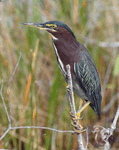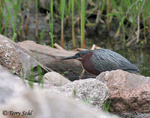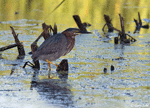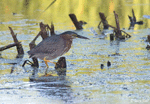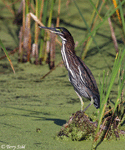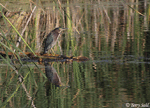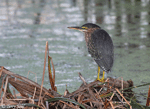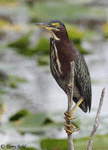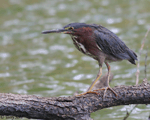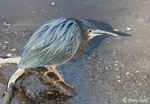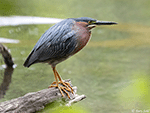| Length: 20 inches | Wingspan: 26 inches | Seasonality: Summer |
| ID Keys: Dark bluish-green back, orange-yellow legs, chestnut neck, dark crown feathers. | ||
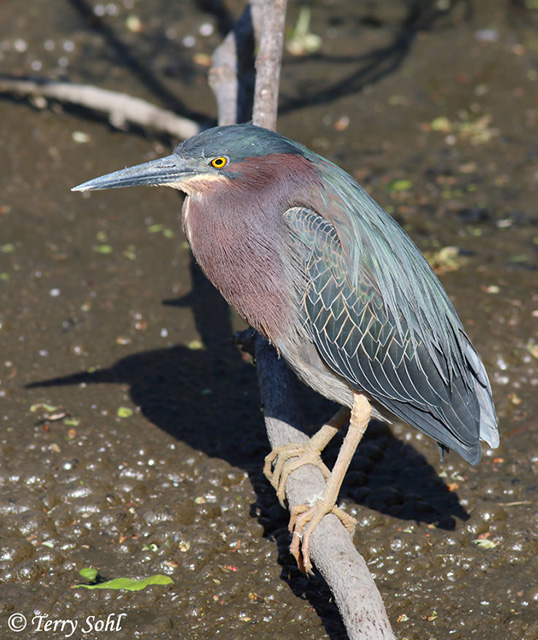 Green
Herons are less gregarious heron than many heron and egret species, and at times, are quite shy and
difficult to approach. Green Herons are generally solitary, nesting as
isolated pairs or small groups, never in the large breeding colonies of
other herons and egrets. Despite their more solitary nature, they are a
quite common species throughout much of the eastern half of the United States.
Green
Herons are less gregarious heron than many heron and egret species, and at times, are quite shy and
difficult to approach. Green Herons are generally solitary, nesting as
isolated pairs or small groups, never in the large breeding colonies of
other herons and egrets. Despite their more solitary nature, they are a
quite common species throughout much of the eastern half of the United States.
Habitat:
Can be found in nearly any aquatic habitat, but prefers small water bodies with both dense emergent vegetation and open water.
Diet:
Mostly small fish. Also crustaceans, frogs, tadpoles, insects, and small rodents.
Behavior:
Primarily forages by standing perfectly still, and striking when prey moves within range. Will also walk slowly through the shallows in search of food.
Nesting:
May and June. They often are solitary nesters, or sometimes nest in small groups. The nest itself is a platform of sticks, placed in a tree or shrub. The female usually lays between 3 and 5 eggs, and both parents help to incubate them. When the eggs hatch, both parents help to feed the young. The young may fledge as early as 3 weeks after hatching, but typically remain in the care of the parents for a few weeks after fledging.
Song:
Crisp skeeow in flight. Can also give a low irregular series of clucking notes.
1Click here to hear the calls of an agitated Green Heron.
2Click here to hear the shorter flight call of a Green Heron.
Migration:
Summers throughout most of the eastern half of the United States, near the West Coast, and in scattered locations elsewhere in the West. Winters near the U.S. West Coast, the Gulf Coast, Mexico, Central America, and South America. Some southern and western populations in the United States are permanent residents.
Interactive eBird Map:
Click here to access an interactive eBird map of Green Heron sightings
Similar Species:
Generally distinctive if seen well, but could potentially be confused with the following stocky wading birds that all could potentially be found in the same habitat.
- Least Bittern - The general profile and structure of a Least Bittern is similar to that of a Green Heron, although Least Bitterns are somewhat smaller. If seen well, plumage differences are readily apparent. Least Bitterns have a dark back and crown, with cinnamon colored flanks and face, while Green Herons have a chestnut-colored neck and flanks. The bill of a Least Bittern is yellow, while that of a Green Heron is dark.
- Black-crowned Night-heron - Another stocky wading bird that shares a similar overall structure with the Green Heron, Black-crowned Night-herons have a dark back and crown, gray wings, and white underparts, compared to the chestnut-colored neck and breast of a Green Heron.
- Little Blue Heron - While not nearly as stocky as a Green Heron, Little Blue Herons do share some plumage similarities, with a purplish neck and breast and dark upperparts that could potentially be confused with the plumage of a Green Heron. Little Blue Herons are much more slender and have a much longer neck than a Green Heron, yet they may sometimes constrict their neck close to the body and strike a pose that makes them look similar to a Green Heron. Note in South Dakota, Little Blue Herons are but rare visitors.
Status:
Populations of Green Heron are generally stable in North America, although there are undoubtedly some local declines due to habitat loss. The species may be increasing its range to the north and west in recent decades. The IUCN lists the Green Heron as a species of "Least Concern".
South Dakota "Hotspot":
The Madison Waterfowl Production Area, just to the west of Lake Madison, is a wonderful place to see these sometimes shy birds, sometimes relatively out in the open. Water in the WPA is generally pretty shallow, often allowing Green Herons to forage well away from the shoreline vegetation which often hides their presence. In the spring, late summer and early fall, it is also a wonderful location for viewing Great Egrets, American White Pelicans, various shorebirds, Common and Forster's Terns, Franklin's and Bonaparte's Gulls, Great Blue Herons, and the occasional Snowy Egret.
The Outdoor Campus in Sioux Falls often has Green Herons that are quite used to people, and seem to be a little more approachable than Green Herons you may find elsewhere.
Further Information:
Photo Information:
May 17th, 2014 - Outdoor Campus in Sioux Falls, South Dakota - Terry Sohl
Additional Photos:
Click on the image chips or text links below for additional, higher-resolution Green Heron photos.
Audio File Credits:
1Paul Marvin - Recorded in Everglades National Park, Florida on May 26th, 2014. Original recording and information from xeno-canto.
2Paul Marvin - Recorded in Brevard County, Florida on July 8th, 2016. Original recording and information from xeno-canto.
| Click on the map below for a higher-resolution view |
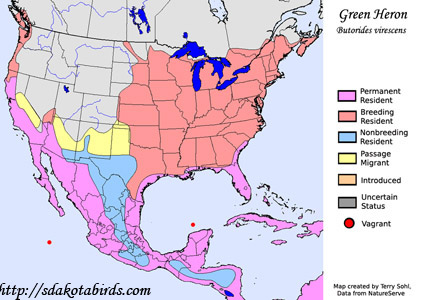 |
| South Dakota Status: Uncommon summer resident in the eastern part of the state, rare in the west. |
Additional Green Heron Photos
Click for a higher-resolution version of these photos
